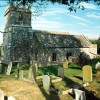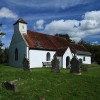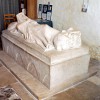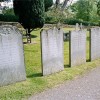One of Dorset’s many and most interesting parochial histories concerns that of Sydling St. Nicholas, situated on Sydling Water a tributary of the Frome about 8 miles north-west of Dorchester. There has been settlement in and around this valley for almost 5,000 years, though the present shape of the village owes its origins to Saxon settlers of the 6th or 7th centuries AD.
In 1936 two Neolithic hand-axes were found at Magston Farm in the village. On the summits of the hills there are round barrows, the graves of tribal elders cut into the chalk soil when embalmed high-born Egyptians were being laid in great stone tombs. Bronze and Iron Age pottery has been recovered in the area and in 1958 a Celtic roundhouse was excavated on Shearplace Hill; a prehistoric village has also been discovered on Buckland Down. A valley-stream, lush water meadows and downland heights were and are the geographical elements for the setting of the story of Sydling St. Nicholas, and the farming tradition so typical of Dorset.
The first mention of Sydling in documented history dates from 933AD when the Winchester Archives record that King Athelstan built a Benedictine abbey at Milton, which endowed thirty hides of land at Sydling. The Domesday Book survey of 1086 found the village to be part of the Hundred of Modbury. Traces of Saxon Strip farming were found at Sherrins Farm in the 1950’s, and this practise may have left its mark in some long narrow rear garden plots to be found in the village.
The valley floor setting has largely determined the linear shape of the settlement, though not just along the single street, as in many other villages of this type. Today the parish extends 4.5 miles from north to south and two miles from east to west and incorporates the hamlets of Hillfield, Magiston, Up Sydling and Huish, but the High Street and East Street form the nucleus of the village. The residential development has traditionally been of high density, but with some dispersal. Homes are typically of thatched stone cottages or brick houses, commonly terraced, with slate roofs and built abutting the main road and stream. Most of the surviving buildings date from before 1800, outstanding examples of which are the Vicarage, East House and Court House.
Court House is a Tudor mansion with later additions. This building has been the administrative centre for the Manor and Rectory from very early in Sydling’s history, and Winchester College records mention tenancies of the Abbot of Milton up until the monastic dissolution under Henry VIII in 1538. In 1544 Henry, through his agent, entered into an arrangement with Winchester College which established leasehold status at the Court, with one Sir Giles Strangewyshe as the first tenant. In 1554 Mary Tudor “desiring favour for her physician Thomas Hughes” arranged with Winchester College for his tenancy at the Court after Sir Gile’s death. Interestingly, the tenancy fell into the hands of Edmund, John and Francis Hardye in 1599 who are mentioned in ‘Concerning Thomas Hardy, a Composite Portrait from Memory’ (ed. D.F.Barber;published by Charles Skilton,1968.) But the first of the great names associated with the Manor is that of Sir Phillip Sydney, who took the lease in 1582. Between 1582 and 1590 it passed to Dame Ursula Walsingham, the widow of Sir Phillip’s Father in law Sir Francis Walsingham, Queen Elizabeth’s secretary of State.
Another archive in Winchester College records that in 1655 Cromwell demanded the surrender of the Sydling Manor Court Rolls. Following the time of Dame Ursula, the Smith family dominated the Manor for 150 years from 1700. A descendent, John Smith Marriott, introduced fox hunting between 1865-6.
The Old Vicarage had improvements made in 1640 by the then Vicar, Ralph Taylor and there was further major restoration in 1778. In 1795 a local man, John Barber, bequeathed money to the Vicar for establishing a school in the village, with provision for a schoolmaster. The building was converted from the former Dissenter’s Meeting House and had 120 places for children aged five upward to be taught arithmetic and needlework. It is recorded that in 1836 there were 116 pupils on the register, with an average daily attendance of 70. The local authority closed the school in 1966.
There were water mills at Ham Farm and Huish Farm powered by water which once flowed in an open course down the High Street. This, when in speight, caused severe flooding on more than one occasion. Indeed, a local man, Tom Churchill, was carried away and drowned during a great storm on June 6th 1889. The school also had once to close because of flooding. But the waterways and meadows have also given the village the traditional activities of cress growing and trout fishing.
Other buildings of architectural or historical interest are the Bakery (1733) and East House (1780). The family of Samuel Newman, the village’s clock and organ maker, who died in 1840, owned the Brewery. With the 1939 Village Hall and Rock’s Farm, these
buildings are grouped around the junction of Dorchester Road, Church Lane, High Street and East Street. There is also a Congregational Chapel of 1834, now a private home and an inn, The Greyhound.
Sydling has held a Fair to St. Nicholas every December 6th and possessed a blacksmith until quite recently. Other interesting facts that Sydling can lay claim to is the curious one that it once possessed the only petrol pump between Dorchester and Yeovil and that during the Second World War many servicemen were billeted in every home that had room for one. The village was well known to Thomas Hardy, whose short story ‘The Grave at the Handcross’ was inspired by it. Furthermore, the church wedding scene in John Schlesinger’s film version of ‘Far from the Madding Crowd’ was shot on location at St. Nicholas Church. Any person named Caddy may also find some significance in the story of a certain Mrs Caddy who, upon leaving the service of Thomas Hardy as his cook, took up that position for the Hawkins family at Sydling Farm in the 1930’s. Also, given the geographical proximity, it would be surprising if there were not an ancestral link between Hardy the writer and the Hardye family occupying the Manor in the 16th century.
In 1819 the village was enclosed, which ended farming arrangements by the Court Baron. Since then farming has declined, and holdings have diminished since Winchester College sold off land and houses in the 1960’s. Sydling saw many social and other changes during the 20th century. Today the college retains two houses and twenty acres of land in the village, which is now in the diocese of Salisbury. Since the 1960’s two new estates have been built, and the influx of new commuter dwellers has imparted a more diverse socio-economic function for Sydling. The 1971 Census revealed that the population at that time was only 321 for the parish. Yet in 1859 the population stood at 675 and included 11 farmers and three carpenters, 2 bakers, 2 grocers, 2 cobblers, 2 thatchers and 1 blacksmith, a bricklayer, tailor, brewer, mason and miller. Since 1973 however, the number of inhabitants had recovered to 425 and more have been added since.
Sydling’s colourful history and rich architectural legacy have made its preservation a high priority and with the new estates the village now comes under the umbrella of Conservation Area status. There are for instance now about fifty listed buildings in the village, of which 14 are in the High Street alone. It is therefore a policy of the planning authority to restrain development so as to keep the village at its present size.




